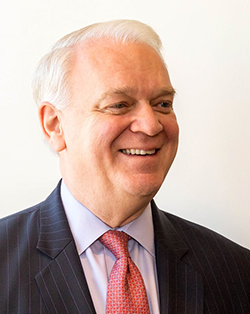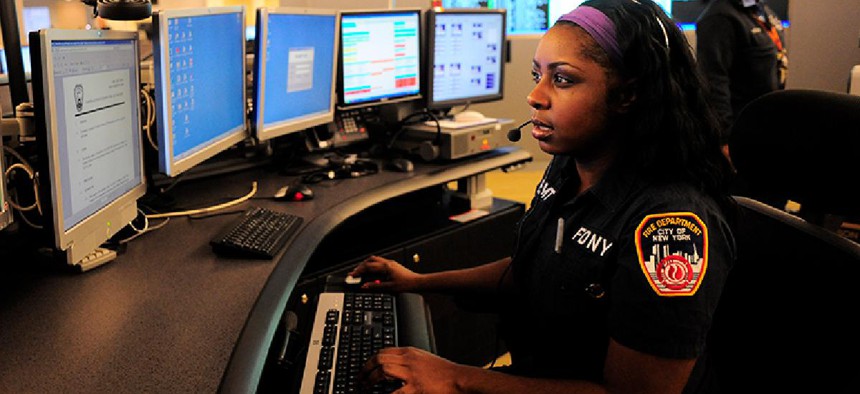As the New York City Department of Information Technology and Telecommunications deputy commissioner for business solutions delivery, David Kirks oversees a number of the department's most important projects, including its emergency response system. DoITT has revamped this system by building a new Public Safety Answering Center, introducing text-to-911 by early next year and rolling out a program called Next Generation 911 by 2022, which will change the face of emergency response. Kirks spoke with City & State about the innovative Next Generation 911 and the city’s robust emergency response system.
RELATED: An interview with DoITT Commissioner Anne Roest
C&S: What does your job entail?
DK: Business solutions delivery is about understanding what different agency customers need from a technology and solutions perspective. That’s to specify the requirements that we need to satisfy, so that’s one group that does that. There’s another group that does all of the user interface design and that’s very much centered around the user experience. Then there’s the group that actually builds the solution, and that’s the software developers. Then of course there’s testing before it gets deployed. And all of that has to be managed by a group of very highly experienced project managers to make sure that the schedule is defined and everyone is doing their task on time until it gets delivered. So we have two main groups, one is in public safety, which is specialized towards the 911 side of things, and then the other part of the division is around all of the other agency requests that we get to support their solutions or their needs.
 C&S: Next Generation 911 is intended to be implemented by the end of 2022. What are your goals for program? How will it supplement traditional 911 calls?
C&S: Next Generation 911 is intended to be implemented by the end of 2022. What are your goals for program? How will it supplement traditional 911 calls?
DK: NextGen is really a transformative program not only in the technology side, but also on the business side. On the technology side, of course, it’s the replacement of the copper wires that come in from the different carriers into the call-taking system, and that gets replaced with full fiber. And so we get much more throughput, we get faster speeds, we get greater ability to upgrade technology components. Then all of this is what we call IP-based, internet protocol-based technology. For example, cellphone users transmit information that’s all digital so there is no translation from digital to analog or analog to digital like what we have today. So it’s much more efficient, the clarity of the information is 100 percent. But to the New Yorker, it allows them to communicate much more fully with the 911 organizations. For example, it allows them to transmit pictures, texts as well as video into the 911 system.
C&S: Will the recently built Public Safety Answering Center II oversee NextGen 911?
DK: We’re coming to a close on the deployment of all of the technology in the two agencies – fire department, which includes emergency medical services, and also NYPD. And we have PSAC I, which is here in Brooklyn. So those centers will be updated to the NextGen technology capabilities. I don’t want you to think that it’s just PSAC II out of the Bronx, but both centers that are really mirror images of each other. So we get 10 million calls every year into 911. So, while today we might have let’s say a 70/30 balance of call takers at PSAC II versus PSAC I, if one of those centers were to go offline, the capacity of each one of those is such that it could handle more than 10 million calls. If we have a recurrence of a Superstorm Sandy, for example, and PSAC I or PSAC II were to go offline for any reason, then the other could pick up all of the call volume seamlessly.
C&S: You’re soliciting proposals for the design of Next Generation 911. What is the status of that process?
DK: We’ve actually received a lot of questions from the perspective of bidders. So we’ve actually given them an extension for proposals. So we want to make sure that they are able to digest all of our answers and clarifications. This is a real critical program for 911 in New York City, and we want to make sure that the authors have ample time to give us their best proposed solution. This is a real big deal because this is New York City. For the city to demonstrate its commitment to 911 technology and being a leader in this area, I think, a lot of the vendors want to be a part of that. It’ll be a huge win for whoever is the successful bidder.
C&S: Do you see the text-to-911 initiative, which will be rolled out early next year, as a trial run for the rollout of NextGen 911?
DK: It’s a step forward towards NextGen. I’m not sure I’d say it’s a trial because it’s on the current technology platform and environment. It does allow people with disabilities – either hearing or speech – to be able to communicate directly with call takers at 911. So we’re working closely with the mayor’s office and people with disabilities on ensuring that this solution meets the needs of his constituents, and we’ve had a number of sessions with his office. We’re going to soon be bringing on subject matter experts in that area to inform us on the development of a solution, and we’re excited about having this out first quarter of next year. The reason I say it’s not a trial run but a step in the right direction is today, with cellphones, the location information that we get from cellphones is really not as precise as what we’ll get with NextGen. Today, we get the cellphone tower location that the cellphone communicates through. With NextGen 911, we’ll actually get the precise location of that cellphone as it transmits its signal. The reason I would agree with you in part is because it allows the NYPD and fire department to look at their business processes and how they’re going to receive textual information and how they’re going to correspond or respond to someone who has, for very good reason, to communicate over text. So, the business processes will undergo quite a change with NextGen and this allows PD and fire to start moving in that direction. But it is an important step.
C&S: You’re also overseeing the upgrade of 311. How are you working to update this program?
DK: That’s a big one because New Yorkers really rely upon 311. We get more than 22 million calls per year. We’ll use the Watson products from IBM. We’ll employ that to help those 311 call takers make sure that they quickly answer questions, address complaints. If they need to turn to Watson, to pull up the most recent information to provide that to New Yorkers, they’ll have that tool at their disposal. But this new platform is going to be much more sustainable and also can be modified by the 311 organization to keep pace with what New Yorkers are asking about and be able to address those questions and problems. It’s a great program and we’re happy that IBM’s on board.
NEXT STORY: How NYC fends off hackers


